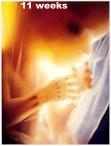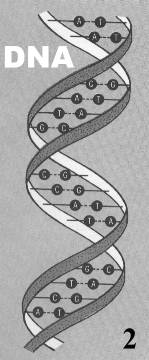 Never referring to their experimental subjects as human helped those researchers rationalize
the terrible acts they committed. The same thing is happening today with those promoting
abortion. (At the right is a human in the womb at 11 weeks.
Never referring to their experimental subjects as human helped those researchers rationalize
the terrible acts they committed. The same thing is happening today with those promoting
abortion. (At the right is a human in the womb at 11 weeks. 
A fiction maintained by many abortionists and their backers is that the fetus is not human. This
game with words has its parallels in the horrific medical experiments Japanese and German
doctors performed on captive humans during World War II. For example, one veteran Japanese
researcher referred to his subjects as "experimental materials" that were "not human." These subjects were frozen and thawed to study frostbite, exposed to chemical weapons, and infected with
deadly pathogens (for instance, Chinese children were given chocolates filled with anthrax
bacteria).(1)
 Never referring to their experimental subjects as human helped those researchers rationalize
the terrible acts they committed. The same thing is happening today with those promoting
abortion. (At the right is a human in the womb at 11 weeks.
Never referring to their experimental subjects as human helped those researchers rationalize
the terrible acts they committed. The same thing is happening today with those promoting
abortion. (At the right is a human in the womb at 11 weeks.
The common-sense answer pro-lifers give abortionists is to wait nine months and then see whether or not the fetus is human. However there is a scientific answer, and one that has been given in the U.S. court system. This is the "Frozen Embryo" case.
In February 1989 Judge W.D. Young heard the "Frozen Embryo" case in Maryville, Blount
County, Tennessee. Junior L. Davis had filed suit against his ex-wife over custody of seven
cryogenically frozen embryos that they had created at a fertility clinic while still married. During
the court proceedings a world-renowned expert in human genetics, Dr. Jerome Lejeune, testified.(2)
 (At the right is a human in the womb at 13 weeks.)
(At the right is a human in the womb at 13 weeks.)
Dr. Lejeune has an M.D. from the University of Paris, and a Ph.D. in genetics at the Sorbonne, Faculty of Science. During his research he discovered the first chromosomal diseases in man, one being Down's Syndrome (previously called Mongolism). Invited to the U.S., he gave the first course of human genetics at the California Institute of Technology. He received the Kennedy Prize from the late President and the highest award in genetics, The William Allen Memorial Award. Among the many international science and medical societies Dr. Lejeune is a member of are The Pontifical Academy of Science, Vatican, and the French Academy of Moral and Political Science. These organizations have provided advice to world leaders on matters such as the danger of the use of atomic energy. Dr. Lejeune's credentials go on, but the point is, he was possibly the most qualified scientist at the time to offer expert testimony on the frozen embryos.

Dr. Lejeune began his scientific testimony describing DNA and how it functions in the human reproductive cycle. He described the DNA molecule as a thread about one meter long and cut in 23 pieces. Each piece is so tightly coiled on itself that it looks like a little rod under the microscope and is called a chromosome. Inside the chromosomes is all the transmitting information from parents to children. As soon as the 23 chromosomes carried by the sperm encounter the 23 chromosomes in the ovum, a new human being is gathered and defined. It is a cross between matter, energy, and information.
The information from the father varies minutely from sperm to sperm, and likewise for each egg. This is why the fertilization process produces a combination that has never occurred before and will never occur again. Each person therefore, is unique. Normally the thousands of sperm, after navigating from the genitalia of the mother through the cervix and uterine cavity encounter the egg inside the fallopian tube. (With in-vitro fertilization, this encounter occurs in a test tube.) Only one sperm fertilizes the egg. You cannot call a sperm and an egg a pre-embryo because you don't know which sperm will make it into the egg first. Thus you don't know what the makeup of the embryo will be. Once the sperm enters, then you have a zygote, and when it divides you have an embryo.
This reproductive process is a very impressive phenomenon because, in a sense, what is reproduced is not the matter, but the information. The matter is a support for the information. This happens in radio, television, or photography where what is printed or reproduced is the information, not the matter. A chromosome with its long threads of tightly coiled DNA is like a minicassette with a symphony recorded on it. If you buy a cartridge with Kleine Nachtmusik on it and play it, the musician would not be reproduced or the notes of music. What would be reproduced is the movement air that transmits to you the genius of Mozart. That is exactly the way the human symphony is played.
All the information for the new human is in the fertilized egg and then is played out in a unique symphony of life. The first cell knows more and is more specialized than any subsequent cell. It splits into three cells, which then split further. (We don't know why, but this three-cell stage is critical.) We do not have a tissue culture here, we have an individual who is building itself according to its own rule.
Dr.Alec Jeffreys in England has invented a probe which, when inserted in specially prepared DNA, reads the DNA information like the bar code we see in a supermarket. Using this, we have found that no two individuals are alike. The probability of finding two persons having identical DNA is one in a billion. So it is not a theory that each of us is unique, nor a statistical inference, but now a demonstration as simple as reading a bar code. The symphony of each life is unique. The individualization of each human seems to occur at the three-cell stage, but just the same, the undifferentiated cell has all the information prewritten in it.
The application of this discussion to the case is that each frozen embryo is a unique human being in its own right. Separately or taken together, these embryos are not spare parts or experimental material to use and then throw away.
Dr. Lejeune wrapped up his opening statement by testifying that as a geneticist, he concludes that the frozen embryo is an early human being that is suspended in time and "cannot be the property of anyone because it is the only one in the world to have the property of building himself. And I would say that science has a very simple conception of man; as soon as he has been conceived, a man is a man."
It is interesting what the U.S. courts have done with this genetic research that Dr. Lejeune reported on in his testimony. The courts have admitted DNA testing in their deliberations, and Judge Kenneth Starr even used it recently in his investigation of President Bill Clinton. But what have the courts done with the scientific determination that the fetus, the embryo even, is a human being? Nothing!

We are faced with the Dred Scott Case all over again. In a gross miscarriage of justice, the Supreme Court in 1857 declared that "Negroes," a certain class of human beings innocent of any crime had "no rights which any white man was bound to respect."(3)
Similarly, our courts today are in effect declaring that a certain class of human beings, though innocent of any crime, have no rights and can be killed out of hand. Is it any wonder that our children are shooting each other in our public schools? Thanks to our courts, life is cheap in America. (Above right is a human in the womb at 17 weeks.
I believe that we will be judged on the very same grounds that we have judged past German and Japanese atrocities, and past racism. Not only are we going to be found guilty of unpunished murder, but also of the associated hypocrisy and lying as well.(4)
APPENDIX: SAMUEL'S STORY
(Edited by Dr. James Dobson)
"What you are witnessing should be designated 'Picture of the Year,' or, perhaps, 'The Picture of the Decade.' It won't be. Most people will never get an opportunity to see it.
The photo depicts a 21-week-old pre-born baby, who was being operated on by a surgeon named Joseph Bruner (It is his finger in the photo). The baby had been diagnosed with spina bifida, which leaves the spinal cord exposed after it fails to develop properly. Unless the gap was closed to protect his nervous system, serious brain damage would likely have occurred before birth. There was no time to lose. Unfortunately, the baby was too immature to survive outside the womb, and corrective surgery had never been performed on a baby this young. However, the parents, Julie and Alex Armas have a deep faith. She is an obstetrics nurse in Atlanta, who had heard through the Internet of Dr. Bruner 's work at Vanderbilt University Medical Center in Nashville. He and his team pioneered these delicate operations. Despite the fact that the procedure has not yet been endorsed in medical journals, the decision was made to attempt it on behalf of little Samuel.
To operate on such a tiny baby required special miniature instruments to be created. The sutures used, for example, were less than the thickness of a human hair. A Caesarean section was then performed to lift the uterus gently from Julie's body, permitting the surgeon to make a small incision through which the operation would be performed. Then, it happened! As Dr. Bruner was probing the opening, the baby's fully-developed hand wrapped itself around the finger of the surgeon. The photograph captures that amazing moment with perfect clarity.
This picture should be shown on every newscast and run in every newspaper in America. Every teenager should also see it. Why? Because it is an unmistakable reminder that growing in the womb of each mother is a baby. It is not a 'blob of tissue,' or a 'product of conception.' A pre-born baby is fully human from the moment of conception. What we see in the photograph expresses that understanding better than a thousand words.
Little Samuel's mother was quoted as saying she and her husband 'wept for days' when they saw the picture. She said, 'This photo reminds us [that] my pregnancy wasn't about disability or illness. It was about a little person.'
That's what human pregnancy and birth are about-a tiny human being with an eternal soul being formed in the 'image of God.' And that's what the media elite fails to comprehend. That's also why they don't want people to see the incredible picture of this precious baby grasping the hand of his physician. I pray that it will not be hidden forever?'